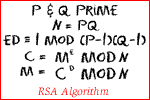1. Private Key Cryptography in a Nutshell
This pseudo-protocol is based on the one-time-pad (aka Vernam) encryption.First of all, you need a secret key. To be efficient, it has to be long (because to each byte of the key will be associated one byte of one of your future messages), and white (i.e. the knowledge of some bytes shouldn't provide any information about any other one).
The secret shared key may be generated by something like :
dd if=/dev/urandom of=our-key bs=1024k count=666
Then, you give your friend mano a mano a copy of the file/cd.
Another way to generate a common private key is quantum key distribution, but it won't be discussed here.
An encrypted message is basically :
- a header : the offset o (where to begin to read the key)
- encrypted data, where the i-th character is e.g.
ei=ci xor ko+i
And the decrypted data is consequently :
di=ei xor ko+i
To summarize : Encrypted = Key xor Message ---> Message = Encrypted xor Key
Once a key is completely used, you need to create another one and transmit it by what I called previously the mano a mano way.
Now how can m friends communicate securely ?
Typically, for peer to peer communication, a total of m(m-1)/2 keys should be created, one for each pair of friends.
For "multicommunication", a total of 2m-m-1 keys should be created, one for each subset of at least two friends. Each member gets the keys corresponding to the subsets he belongs to, and that makes 2m-1-1 keys.
A message consists in :
- an identifier telling which key is used (it defines who will be able to read the message)
- the offset
- the encrypted data
The difficulty here is to prevent the same bytes of the key to be used more than once.
If you are not able to share securely a secret key, you may consider asymmetric encryption, but be aware that none of the algorithms relying on it has been proven time-resistant.

Is this some kind of a joke ?
2. Public Key Cryptography in a Nutshell
The concepts behind asymetric cryptography are not intuitive and obvious. Basically, the idea is that if you want to send a private message to Jonas, you will need his public key ; by combining his public key with your clear message, you will produce a box you can make available to everyone, but only he will be able to open it. Conversely, if you want Jonas to send you a private message, you have to communicate him your public key (completely different from his own). He will then send you a box, and only you will be in measure to open it, with your own private key.Asymetric cryptography : RSA in a nutshell
The RSA algorithm (Rivest-Shamir-Adleman) assumes it is difficult to factorize large numbers.The goal of this section is to understand the following illustration :

"RSA in a nutshell"
in a nutshell
Two words about arithmetic modulo n
RSA algorithm is based on basic arithmetic. Using Euclid's algorithm, you can show that : ∀ (a,b) ∈ Z2 : ∃ (m,n) ∈ Z2 / a.n+b.m=1 <=> gcd (a,b)=1 (Bézout's theorem).Now let's consider the ring (Z/nZ,+,*). The invertible elements for * constitute its group of unities ; we write it (Z/nZ)*.
A way to characterize the unities is the following. Let â be a member of (Z/nZ).
<=> ∃ (u,k) ∈ Z2 / a*u = 1 + k*n
<=> ∃ (u,k') ∈ Z2 / a*u + n.k' = 1
<=> gcd (a,n) = 1
We define now Euler's totient function φ on natural integers by saying that φ(n) is the number of natural integers smaller than n and relatively prime with n.
For example, div(12)={1,5,7,11} so φ(12)= 4, if n is prime then φ(n)=n-1, if m and n are coprime, φ(mn) = φ(m) φ(n).
From above, you should get that #(Z/nZ)*=φ(n).
Therefore we can label the elements of (Z/nZ)* â1, â2,...âφ(n).
By using the fact that for any â, â(Z/nZ)* = â{â1, â2, ..., âφ(n)}= {ââ1, ââ2, ..., ââφ(n)} = (Z/nZ)*
Manufacturing keys
- Take p and q prime, and compute N = pq.
- Choose e prime with (p-1)(q-1)
- From Bézout's theorem, you can find d and k s.t. ed=1+k(p-1)(q-1)
If someone wants to send you an encrypted message x, he sents y = xe mod N.
Using ed = 1+k(p-1)(q-1), you see easily that xed = x1+k(p-1)(q-1) = x*(x(p-1)(q-1))k
Because φ(N) = φ(pq) = (p-1)(q-1), x(p-1)(q-1) mod N = 1, that is : xed mod N = x.
To decrypt y, you use your private key d, by computing : yd mod N = xed mod N = x
That's it !
Most of the secure requests on the internet are transmitted via Secure Socket Layer (SSL), a protocol based on asymmetric cryptography.
An interesting exercise for the reader is to derive a way to create digital signatures from the RSA cryptosystem (really, try it!).
That's all, folks.
Little Neo, 2005-2007